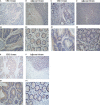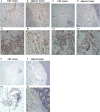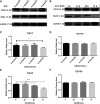Use of aspirin in the prevention of colorectal cancer through TIGIT-CD155 pathway
- PMID: 31090213
- PMCID: PMC6584546
- DOI: 10.1111/jcmm.14332
Use of aspirin in the prevention of colorectal cancer through TIGIT-CD155 pathway
Abstract
Colorectal cancer (CRC) is one of the most widespread malignant cancers, with a high incidence and mortality all over the world. Aspirin (ASA) otherwise known as acetylsalicylic acid, is a non-steroidal anti-inflammatory drug that has shown promising results in the prevention of chronic diseases, including several cancers. In previous studies, aspirin has been shown to reduce the incidence of CRC. Immune checkpoint blockade of T cell Ig and ITIM domain receptor (TIGIT) alone or combined with other immune checkpoint blockades moleculars has gained impressive results in the treatment of the melanoma and glioblastoma. Here, we found that TIGIT and Poliovirus receptor (PVR, CD155) are expressed in tumour cells; the TIGIT and CD155 protein expression in cancer tissue has been found to be significantly higher than that in the precancerous tissue. T cell Ig and ITIM domain receptor and CD226 were expressed in the lymphocytes near the tumour tissue and the adjacent tissues. Aspirin has been found to inhibit cancer cell viability and promote CRC cell apoptosis.Similarly, aspirin has also been found to increase pro-apoptotic protein Bax's expression. We found that the expression of TIGIT decreased with an increase in the concentration of aspirin and that the suppression of TIGIT can affect the effect of aspirin on cell proliferation. In this paper, we found that aspirin attenuates cancer cell proliferation and induces CRC cells apoptosis by down-regulating the expression of TIGIT, which provides new evidence for the application of aspirin in cancer treatment.
Keywords: CD155; CD226; TIGIT; aspirin; cell proliferation; colorectal cancer.
© 2019 The Authors. Journal of Cellular and Molecular Medicine published by John Wiley & Sons Ltd and Foundation for Cellular and Molecular Medicine.
Conflict of interest statement
The authors declare no conflict of interest.
Figures







Similar articles
-
Aspirin Inhibits Colorectal Cancer via the TIGIT-BCL2-BAX pathway in T Cells.Int J Med Sci. 2024 Aug 1;21(10):1990-1999. doi: 10.7150/ijms.98343. eCollection 2024. Int J Med Sci. 2024. PMID: 39113892 Free PMC article.
-
CD155/TIGIT signaling regulates the effector function of tumor-infiltrating CD8+ T cell by NF-κB pathway in colorectal cancer.J Gastroenterol Hepatol. 2022 Jan;37(1):154-163. doi: 10.1111/jgh.15730. Epub 2021 Nov 12. J Gastroenterol Hepatol. 2022. PMID: 34734434
-
Melanoma Cells Control Antimelanoma CTL Responses via Interaction between TIGIT and CD155 in the Effector Phase.J Invest Dermatol. 2016 Jan;136(1):255-63. doi: 10.1038/JID.2015.404. J Invest Dermatol. 2016. PMID: 26763445
-
CD155/TIGIT, a novel immune checkpoint in human cancers (Review).Oncol Rep. 2021 Mar;45(3):835-845. doi: 10.3892/or.2021.7943. Epub 2021 Jan 19. Oncol Rep. 2021. PMID: 33469677 Review.
-
CD155, an onco-immunologic molecule in human tumors.Cancer Sci. 2017 Oct;108(10):1934-1938. doi: 10.1111/cas.13324. Epub 2017 Aug 18. Cancer Sci. 2017. PMID: 28730595 Free PMC article. Review.
Cited by
-
Role of CD155/TIGIT in Digestive Cancers: Promising Cancer Target for Immunotherapy.Front Oncol. 2022 Mar 30;12:844260. doi: 10.3389/fonc.2022.844260. eCollection 2022. Front Oncol. 2022. PMID: 35433470 Free PMC article. Review.
-
Acetylsalicylic Acid Promotes Corneal Epithelium Migration by Regulating Neutrophil Extracellular Traps in Alkali Burn.Front Immunol. 2020 Oct 15;11:551057. doi: 10.3389/fimmu.2020.551057. eCollection 2020. Front Immunol. 2020. PMID: 33178183 Free PMC article.
-
Tumorigenic bacteria in colorectal cancer: mechanisms and treatments.Cancer Biol Med. 2021 Sep 30;19(2):147-62. doi: 10.20892/j.issn.2095-3941.2020.0651. Cancer Biol Med. 2021. PMID: 34586760 Free PMC article. Review.
-
Prognostic Role of TIGIT Expression in Patients with Solid Tumors: A Meta-Analysis.J Immunol Res. 2021 Nov 30;2021:5440572. doi: 10.1155/2021/5440572. eCollection 2021. J Immunol Res. 2021. PMID: 34888386 Free PMC article.
-
Target therapy of TIGIT; a novel approach of immunotherapy for the treatment of colorectal cancer.Naunyn Schmiedebergs Arch Pharmacol. 2025 Jan;398(1):231-241. doi: 10.1007/s00210-024-03346-7. Epub 2024 Aug 19. Naunyn Schmiedebergs Arch Pharmacol. 2025. PMID: 39158733 Review.
References
-
- Bains S, Mahic M, Myklebust T, et al. Aspirin as secondary prevention in patients with colorectal cancer: an unselected population‐based study. J Clin Oncol. 2016;34:2501‐2508. - PubMed
-
- Bos C, Diks S, Hardwick J, Walburg K, Peppelenbosch M, Richel D. Protein phosphatase 2A is required for mesalazine‐dependent inhibition of Wnt/beta‐catenin pathway activity. Carcinogenesis. 2006;27:2371‐2382. - PubMed
-
- Svrcek M, Cosnes J, Tiret E, Bennis M, Parc Y, Fléjou J. Expression of epidermal growth factor receptor (EGFR) is frequent in inflammatory bowel disease (IBD)‐associated intestinal cancer. Virchows Arch. 2007;450:243‐244. - PubMed
-
- Spano J, Lagorce C, Atlan D, et al. Impact of EGFR expression on colorectal cancer patient prognosis and survival. Ann Oncol. 2005;16:102‐108. - PubMed
Publication types
MeSH terms
Substances
LinkOut - more resources
Full Text Sources
Medical
Research Materials

